Ever been cruising down the road when a mysterious wrench symbol on your dashboard suddenly pops up? Yeah, me too—and it’s enough to make your stomach drop. The first time I saw that car light with a wrench, I was sure my car was about to give up on me. But after a quick check and some digging, I realized it’s not always a major issue—it’s your car’s way of saying, “Hey, something needs attention.” In this post, I’ll break down exactly What Tools Should I Keep in My Car means on a car, why it shows up (especially that tricky wrench light on Ford and Honda models), and what you should do next—without the panic. Let’s make sense of that dashboard mystery together.
Why You Need a Car Tool Kit
Let me tell you—nothing makes you feel more helpless than standing on the side of the road with a flat tire and no tools in the trunk. I’ve been there. One time, I had to flag down a stranger just to borrow a jack. That moment stuck with me, and ever since, I’ve made sure my car tool kit is always packed and ready.
So, why should you keep tools in your car? Simple: peace of mind. Whether it’s a loose battery cable, a low tire, or a blown fuse, having the right tools can turn a bad day into a quick fix. You don’t need a full mechanic’s shop—just a vehicle tool kit with the basics for roadside fixes or small emergencies.
According to AAA, millions of roadside calls each year could be solved by drivers themselves—if they had the right gear. An essential car tool kit isn’t about being an expert; it’s about being ready. A flashlight, jumper cables, or a tire gauge can save time, money, and frustration. And honestly, it just feels good to handle a situation without calling for help.
The Essentials: Tools for Roadside Emergencies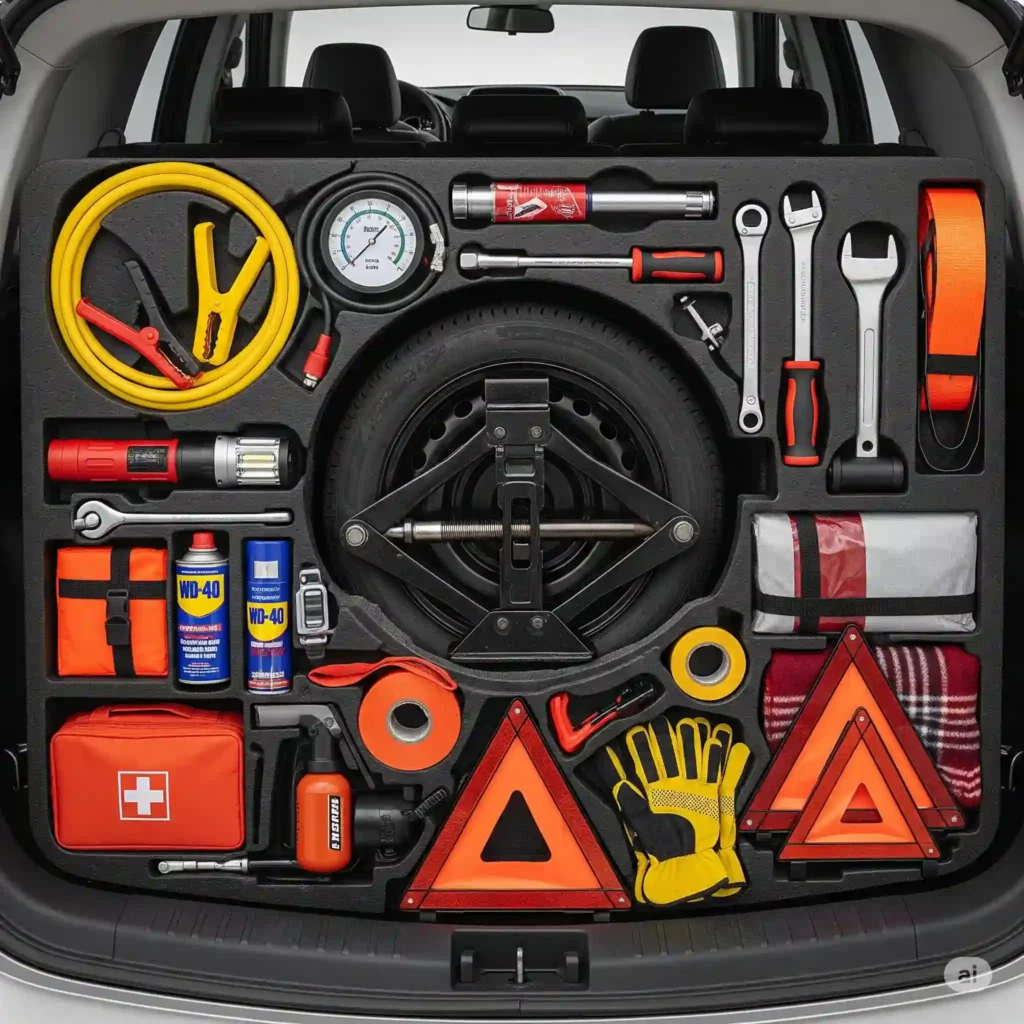
If your car’s ever refused to start in the middle of nowhere, you know the panic that hits. Mine did once—battery completely dead, and of course, I had no jumper cables. Since that cold morning, I’ve never driven without my good tool kit for the car. Trust me, a few smart items in your trunk can make all the difference.
So, what tools should I keep in my car for emergencies? Here’s a simple checklist I swear by:
- Jumper Cables or a Jump Starter
Dead batteries happen—usually at the worst time. Jumper cables are a must, but a portable jump starter? Even better. You won’t need to rely on another car. - Tire Pressure Gauge
Low tire pressure kills mileage and can be dangerous. A small gauge helps you catch it before it becomes a flat. - Spare Tire, Jack, and Lug Wrench
Sounds obvious, right? But many drivers forget to check if these are actually in the car—and usable. Don’t wait until you’re on the shoulder at night to find out. - Flashlight (Preferably LED)
Ever tried changing a tire in the dark using your phone light with 3% battery? Not fun. Keep a strong flashlight and extra batteries. - Tow Strap
It’s not just for towing—use it for getting unstuck in mud, snow, or sand. It’s lightweight but a lifesaver when needed. - Duct Tape
Honestly, duct tape is magic. Temporary fixes for broken mirrors, leaky hoses, even a loose bumper—it’s done it all for me. - WD-40
Rusted bolts or squeaky parts? A small can of WD-40 handles it. One time, it helped me loosen a stuck tire after a long winter. - Portable Tire Inflator
If your tire is low but not flat, this gadget can pump it up enough to get you to a shop—no tow truck needed. - First-Aid Kit
For more than just you—kids, passengers, or helping someone else. A basic kit with bandages, antiseptic, and gloves is priceless. - Reflective Triangles or Flares
If you’re stuck on a highway shoulder, these make you visible to other drivers—especially at night or in bad weather. - Blanket and Gloves
Flat tires don’t wait for sunny days. A warm blanket and gloves can keep you safe and comfortable in the cold.
Each of these tools plays a role in either getting you back on the road quickly or keeping you safe while you wait. You don’t need a giant car toolbox—just a compact, smart selection that covers the basics. Keep them together, check them seasonally, and you’ll never be caught unprepared again.
For Minor Repairs and Quick Fixes
Ever had something go wrong with your car that wasn’t quite an emergency—but still stopped you cold? That was me one rainy evening when my windshield wiper flew off mid-drive. No big accident, but without tools, I was stuck waiting it out. That moment taught me something important: a few basic tools can save the day, even when it’s not a crisis.
So, what tools should I keep in my car for quick repairs? You don’t need a full garage—just a handful of go-to items that cover the small but frustrating issues. Here’s what I rely on:
- Screwdrivers (Flathead and Phillips)
These are like the Swiss army knives of car fixes. Whether it’s a loose battery terminal or a hanging panel, a quick turn can solve it. I once tightened a flapping mudguard mid-trip using just a screwdriver—and saved myself from hours of that awful rattling sound.
A basic screwdriver set helps tighten or remove small car parts on the spot.
- Adjustable Wrench
It’s perfect for bolts that vary in size. When I had to re-tighten a loose battery clamp, this tool made it easy. No fumbling with ten different wrenches—just one that adjusts.
An adjustable wrench works for multiple bolt sizes, saving space and time.
- Pliers (Needle Nose and Slip Joint)
From pulling out a nail stuck in a tire to holding a bolt in place, these are lifesavers. I used needle-nose pliers once to rescue a dropped fuse behind my dashboard—it took seconds instead of a sweaty hour.
Pliers offer grip and control for tricky spots where fingers can’t reach.
- Socket Set
Okay, this one sounds fancy, but a small set goes a long way. I’ve used it to tighten a loose battery mount and even to tweak my seat bolts. Keep one that matches your car’s basic nuts and bolts.
A socket set allows faster, more secure tightening than a basic wrench.
- Utility Knife
Need to cut a zip tie, strip a wire, or slice duct tape? A sharp utility knife is your best friend. I once used mine to trim a hose that had cracked on the edge—worked just long enough to reach the garage.
A utility knife handles cutting tasks cleanly and safely.
- Electrical Tape
It’s a quick fix for wires or even to stop a rattle. Once, my interior light wire started flickering like a horror movie. A few wraps of tape, and peace was restored.
Electrical tape helps insulate and patch small wiring issues temporarily.
- Zip Ties
Strong, light, and surprisingly versatile. I’ve secured a loose bumper, held my trunk liner in place, and even used them to stop cables from dragging.
Zip ties are great for fast, strong, no-fuss fixes.
- Multi-Tool
Think of it as your emergency toolbox in one piece. Screwdrivers, blades, tiny pliers—whatever you need in a pinch. Mine once helped me fix a stuck gas cap release.
A good multi-tool covers many minor repair needs when space is limited.
Honestly, you don’t need to be a car expert to use these. Most repairs take just a few minutes—if you have the right tools. And there’s something empowering about solving a problem yourself, without calling for help or spending money at the shop.
Every item on this list has helped me or someone I know. They’re small, cheap, and easy to store. But when something goes wrong, they feel like magic. So if you’re wondering what tools should I keep in my car for those “not-quite-emergency” moments—this is the list.
Just toss them in a pouch, tuck it in your trunk, and forget about it—until the day you’ll be so glad it’s there.
Useful Extras to Keep in the Car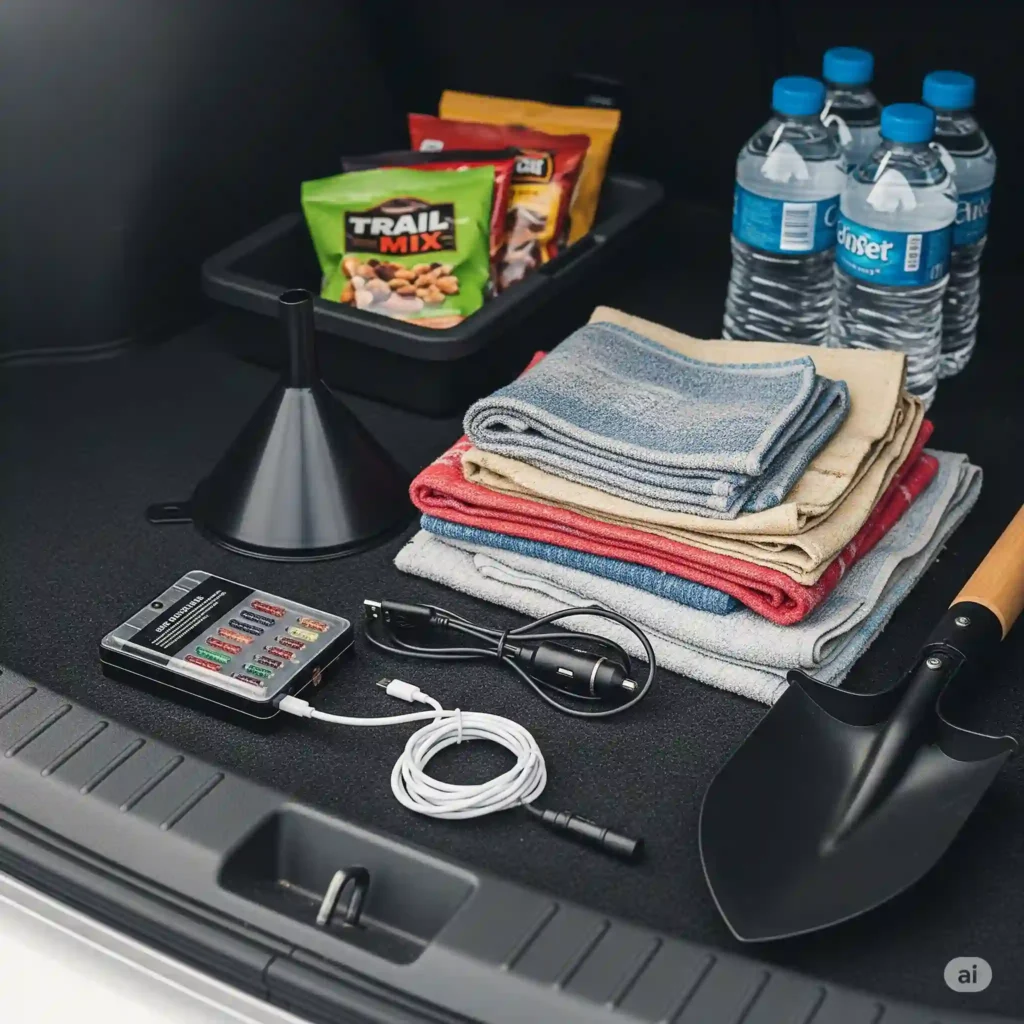
Some things may not look like tools, but when the moment hits, they matter just as much. I learned this the hard way one night stuck in traffic, engine off, phone at 8%, and no charger in sight. I wasn’t stranded exactly—but it felt like it. That’s when I realized: not everything in your car toolbox has to be made of metal. Sometimes, the small stuff saves the day.
So what should I keep in my car beyond tools? Here’s what’s earned a permanent spot in my trunk:
Small Funnel
Sounds boring, right? But try pouring oil or coolant without one. I once ended up with half the bottle on the engine block—and a mess I still regret.
→ A funnel helps you refill fluids cleanly, without spills or wasted money.
Rags or Shop Towels
I keep a few old t-shirts in my car. Perfect for wiping dipsticks, drying hands, or cleaning spills. Once, I used one as a glove to handle a hot battery terminal.
→ Rags can keep you clean and prevent burns or messes when fixing your car.
Extra Fuses
Blown fuses are sneaky. Your radio dies, the AC stops, or your lights go out—then you’re hunting for answers. I’ve swapped a fuse in minutes, and it felt like a superpower.
→ Carrying a few common-size fuses can fix sudden electrical issues fast.
Phone Charger (USB + Car Adapter)
If your phone dies, especially during a roadside emergency, you’re cut off from maps, calls, and help. I keep a fast charger and backup cable tucked in the glove box.
→ A phone charger keeps you connected when it matters most.
Water and Snacks
No joke, a granola bar and a bottle of water once turned a frustrating two-hour traffic jam into something bearable. Especially during summer or long drives, they’re gold.
→ Snacks and water help you stay hydrated and focused when delays hit.
Small Shovel
If you live where it snows or rains hard, this one’s key. I once used mine to dig my tire out of muddy shoulder gravel after pulling over too far. Took ten minutes and zero towing bills.
→ A compact shovel can help you escape mud, snow, or sand with minimal effort.
These extras don’t take up much space, but when the situation calls for it, they feel like miracles. That’s the thing about a good tool kit for your car—it’s not just wrenches and screwdrivers. It’s about thinking ahead, packing smart, and staying calm when things go sideways.
And here’s the truth: you never really know what tool (or snack, or towel) will be the hero until you need it. That’s why I keep these in the car—and why you should, too.
How to Organize Your Car Toolbox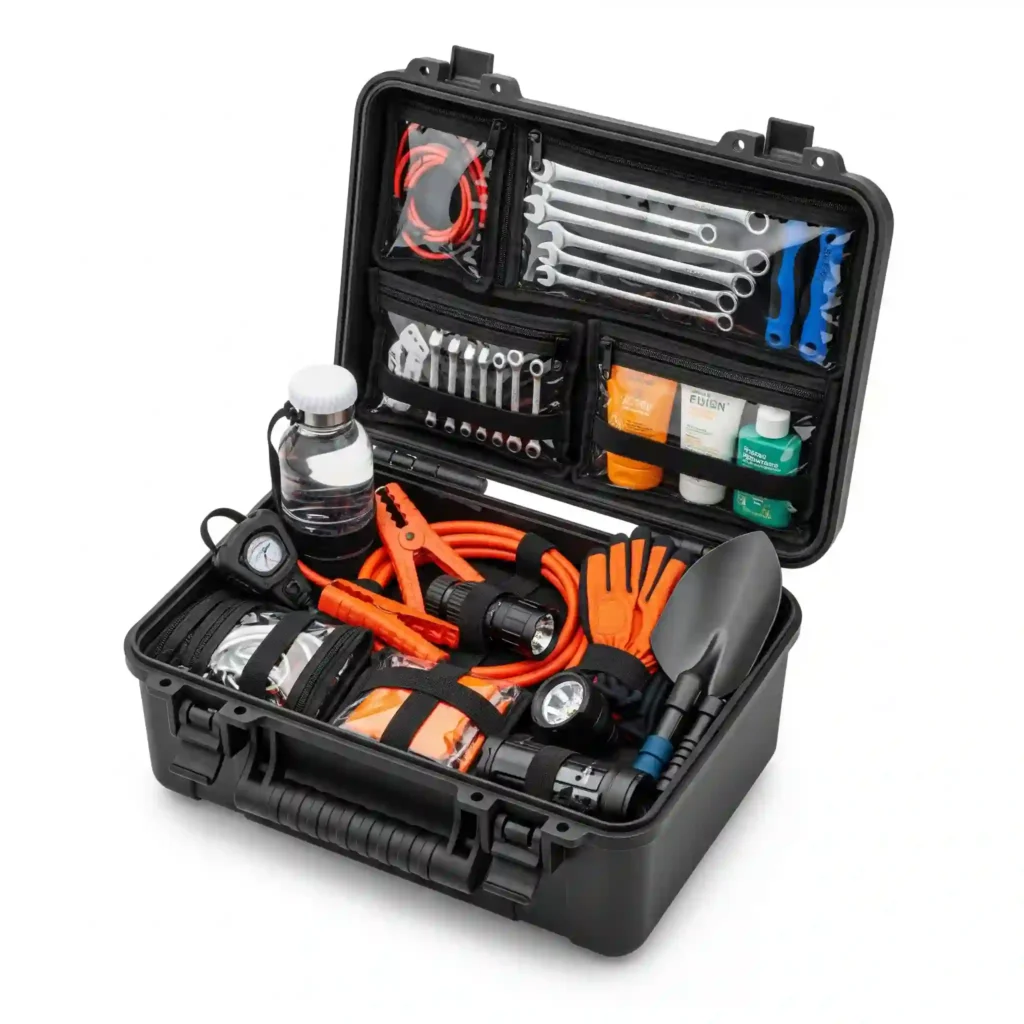
Ever popped your trunk and realized you have tools somewhere in there—but you’d have to dig past old grocery bags and an umbrella from 2017 to find them? I’ve been there. A car toolbox is only helpful if you can find what you need when you need it. That’s why how you organize your car tool kit matters just as much as what’s inside.
The best way to organize your car toolbox is to use a compact, weatherproof container and group tools by type and use. This keeps everything neat, dry, and easy to grab in a hurry.
I use a small plastic bin with a locking lid—nothing fancy, but it fits perfectly in my trunk and keeps everything dry even on rainy days. You could also go for a zippered tool bag if you’re tight on space. Bonus: it doesn’t slide around like a toolbox might. If your car doesn’t have a flat trunk, consider a soft-sided bag that fits under the seat.
Now here’s a trick that changed everything for me: divide your gear into categories. I use zip pouches or small drawstring bags to separate things like electrical tools, emergency items, and quick-reach stuff. For example, jumper cables and the flashlight go in one pouch, tools like wrenches and screwdrivers in another. That way, I’m not digging through a sea of metal when I just need a flashlight.
Keep your most-used items in an easy-to-reach spot. My tire gauge and flashlight live in the glove box because I’ve needed them at night or during gas stops more than once. The rest stays packed in the trunk. No more crawling into the backseat in the dark.
One thing I’ve learned living in a place where winters can be brutal—your car toolbox needs a seasonal update. In summer, I toss in sunscreen and extra water. In winter, I add a foldable shovel, hand warmers, and thicker gloves. Your gear should match your climate and your drives.
To organize your car toolbox effectively, use space-saving containers and rotate items based on season and travel needs. That way, your car stays clutter-free but still fully prepared.
And here’s something people forget: check your kit every few months. I once realized my flashlight batteries had died, and my electrical tape had melted into a gooey mess. Now, I set a reminder to do a 5-minute check every season. It’s quick, and it gives me peace of mind.
The whole idea is to build a car toolbox that’s useful, not overwhelming. You don’t need to carry half your garage—just enough to stay safe, fix small issues, and stay ready for surprises. Think of it like prepping a go-bag for your car: clean, simple, and smart.
So if you’re wondering how to organize your car toolbox in a way that works in real life—start small, think in categories, and make it easy to grab what you need without digging through clutter. Trust me, your future self will thank you at 10 p.m. on a roadside with a flat.
Tool Kits vs. DIY: Should You Buy or Build One?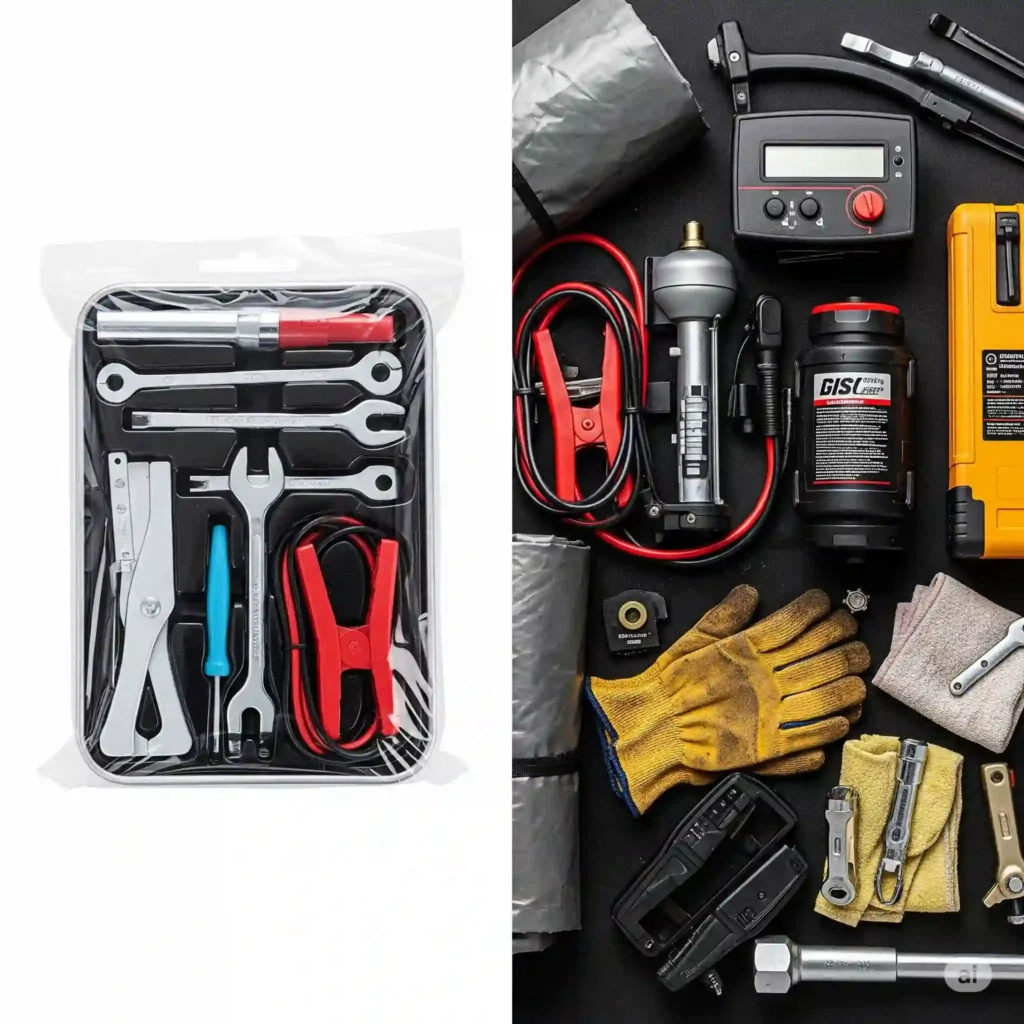
Let’s be honest—we’ve all stood in the car aisle, staring at a shiny pre-packed car tool kit, wondering, “Should I just grab this or build my own?”
Here’s the quick answer: Buying a ready-made vehicle tool kit is easier, but building your own gives you more control and better quality.
When I bought my first car, I went with a cheap, all-in-one kit. It looked solid on the outside, but when I actually needed it—yep, flat tire in the rain—the wrench bent. Literally. That day taught me a lesson: not all tool kits are made equal.
Most pre-packed tool kits are designed for “just in case,” not real situations. They often miss out on key items like a jump starter or a tire inflator. Some even include tools so flimsy, they break on the first use. Sure, they’re convenient. But they may not help much when you’re actually stuck on the side of the road.
Now, building your own kit takes a bit more effort. But here’s the win—you get to pick every tool. You can choose a good tool kit for your car based on your actual needs, the weather in your area, and your driving habits. For example, I live where monsoon season loves to surprise us, so a tarp, gloves, and extra rags are must-haves in my trunk.
If you’re leaning toward buying one, look for a kit with strong reviews, full-sized tools, and room to add extras. Some brands offer solid starter kits that cover the basics—just don’t forget to toss in the things they leave out (like duct tape or a flashlight).
So, should you buy or build? If you’re new to cars or want something quick, start with a decent pre-made kit and upgrade it over time. But if you’re like me and want gear you can actually trust, building your own essential car tool kit is 100% worth it.
FAQs: Answering Common Questions About Car Tool Kits
Q1: What tools should I always keep in my car?
You should always keep jumper cables, a flashlight, a tire inflator, a first-aid kit, and basic tools in your car for safety and minor repairs.
Q2: What is the best car tool kit for emergencies?
The best car tool kit for emergencies includes a jump starter, tire tools, a flashlight, duct tape, and reflective gear for safety and quick fixes.
Q3: Can I build my own vehicle tool kit?
Yes, you can build your own vehicle tool kit with tools like screwdrivers, pliers, zip ties, and more, tailored to your car and personal needs.
Q4: What’s the difference between a car tool kit and a car toolbox?
A car tool kit is a ready-made set of tools. A car toolbox is a custom box where you keep the tools you choose and add based on your needs.
Q5: Is it worth carrying a full set of tools in the trunk?
Yes, carrying a full set of tools in your trunk helps you stay prepared for car troubles, small repairs, and emergencies on the road.
Final Thoughts: Stay Ready, Not Sorry
If there’s one thing I’ve learned from years on the road, it’s this: you never regret being prepared—only not being prepared. A dead battery, a flat tire, or even a loose wire can happen when you least expect it. And trust me, they usually strike at the worst time—like when you’re already running late or it’s pouring rain.
So, what tools should I keep in my car? Start with the essentials, add what suits your needs, and build a kit that feels like a safety net. Whether it’s your daily commute, a weekend trip, or late-night drives, knowing your car toolbox is ready brings real peace of mind. I can’t count how many times a simple screwdriver or roll of duct tape saved the day.
Every driver’s tool kit should reflect their vehicle and their reality. Drive in a cold area? Toss in a thermal blanket. Got kids? Add extra snacks. Live in the city? Maybe you won’t need a shovel—but a tire inflator and jumper cables are must-haves. Your car tool kit isn’t just about tools—it’s about feeling confident that you can handle small bumps along the way.
The best part? You don’t need to be a mechanic to be prepared. Just having a few smart tools in the trunk can turn an emergency into a minor hiccup. It’s like packing an umbrella—you may not always need it, but when you do, you’ll be so glad it’s there.
So here’s my challenge to you: open your trunk today and ask yourself—am I ready? If not, start small. Build your kit piece by piece. And as you do, you’ll find that sense of “I’ve got this” starts to grow.
Let’s keep this conversation going—what’s in your car tool kit? Got a story to share or a tip I missed? Drop it in the comments. Someone out there might need that exact piece of advice tomorrow.

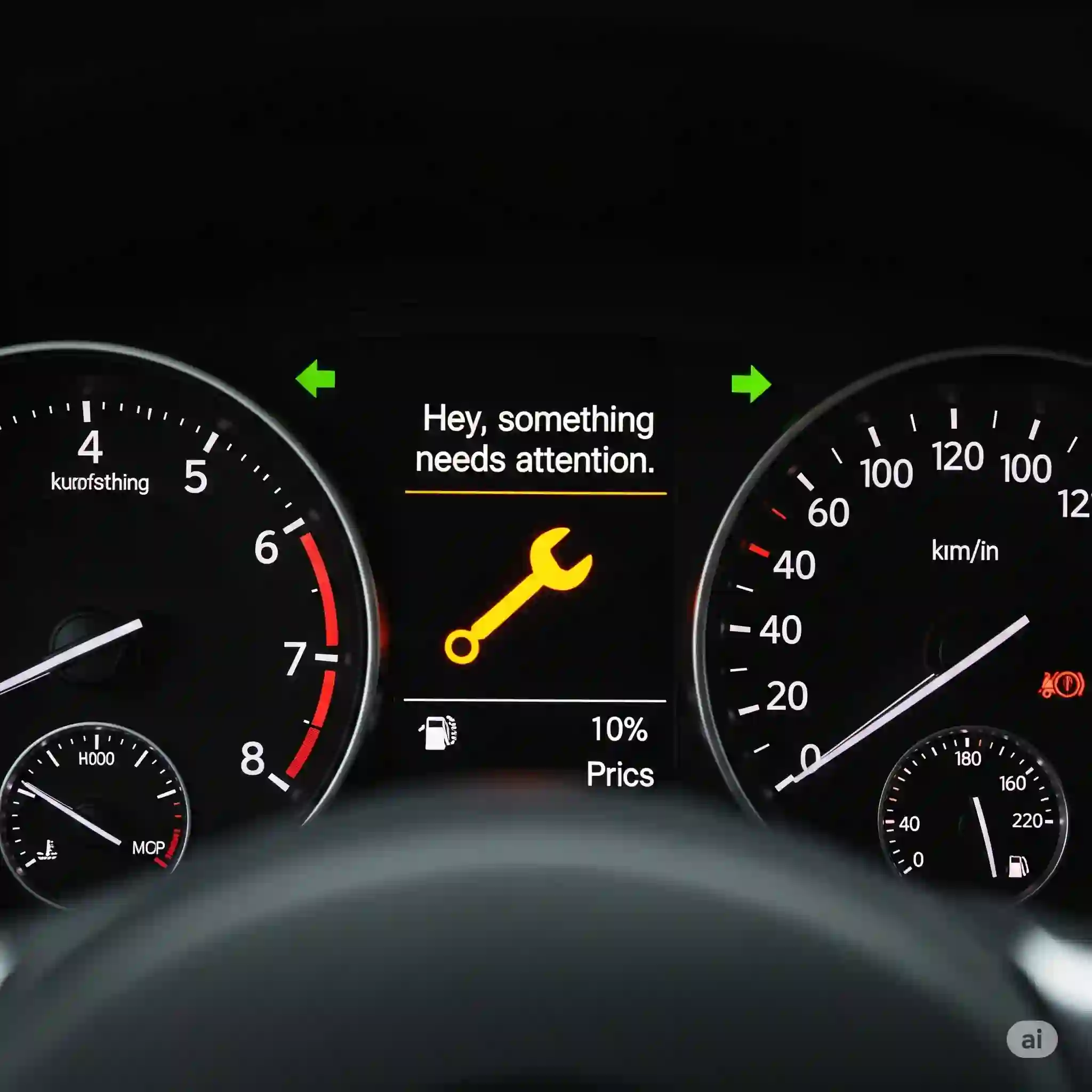
1 thought on “What Tools Should I Keep in My Car Now”